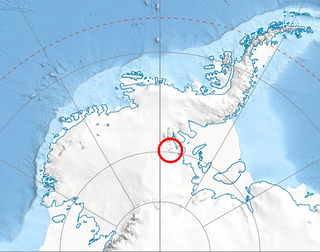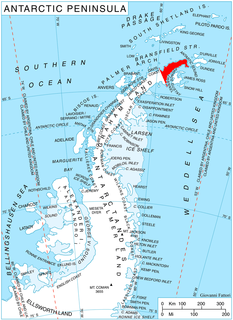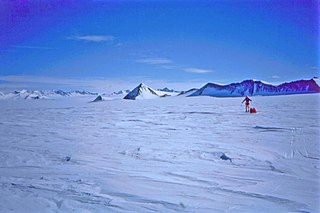
The Heritage Range is a major mountain range, 160 km (99 mi) long and 48 km (30 mi) wide, situated southward of Minnesota Glacier and forming the southern half of the Ellsworth Mountains in Antarctica. The range is complex, consisting of scattered ridges and peaks of moderate height, escarpments, hills and nunataks, with the various units of relief set off by numerous intervening glaciers.

The Dater Glacier is a steep valley glacier in Antarctica, 24 nautical miles long and from 1 to 3 nautical miles wide, flowing northeast in a sinuous course from the eastern slopes of the Vinson Massif between Sullivan Heights and Veregava Ridge to Rutford Ice Stream which borders the eastern flank of the Sentinel Range, Ellsworth Mountains. At the lower end the Dater Glacier coalesces with the terminus of the Ellen Glacier, the two emerging from the Sentinel Range as one stream just north of the Flowers Hills.

The Independence Hills are a line of rugged hills and peaks, 10 miles (16 km) long, with mainly bare rock eastern slopes. They lie 3 miles (5 km) southeast of the Marble Hills and form the southern segment of the west wall of Horseshoe Valley, in the Heritage Range of Antarctica. The Independence Hills were mapped by the United States Geological Survey from ground surveys and U.S. Navy air photos, 1961–66. The name was applied by the Advisory Committee on Antarctic Names in association with the name "Heritage Range".

Acosta Glacier is a glacier about 2 miles (3 km) long flowing north from Thurston Island just east of Dyer Point in Antarctica. It was named by the Advisory Committee on Antarctic Names (US-ACAN) after Alex V. Acosta of the United States Geological Survey (USGS) in Flagstaff, Arizona. He is a computer and graphic specialist, and was part of the USGS team that compiled the 1:5,000,000-scale Advanced Very High Resolution Radiometer satellite image maps of Antarctica and the 1:250,000-scale Landsat image maps of the Siple Coast area in the 1990s.

Union Glacier, is a large, heavily crevassed glacier which receives the flow of several tributaries and drains through the middle of the Heritage Range, Ellsworth Mountains, Antarctica. The glacier drains from the plateau at Edson Hills on the west side of the range and flows east between Pioneer Heights and Enterprise Hills. Union Glacier was mapped by U.S. Geological Survey (USGS) from surveys and U.S. Navy (USN) air photos, 1961-66. The name was applied by Advisory Committee on Antarctic Names (US-ACAN) in association with the name Heritage Range.
Chappell Peak is a peak, 1,860 metres (6,100 ft) high, standing 3 nautical miles (6 km) south of Schoeck Peak on the south side of the Enterprise Hills, overlooking the head of Horseshoe Valley in the Heritage Range. It was mapped by the United States Geological Survey from surveys and from U.S. Navy air photos, 1961–66, and named by the Advisory Committee on Antarctic Names for Richard L. Chappell, scientific aide at Little America V Station in 1957.
The Enterprise Hills are a prominent group of largely ice-free hills and peaks in the form of an arc. The feature extends for about 30 nautical miles (60 km) to form the north and northeast boundary of Horseshoe Valley in the Heritage Range of the Ellsworth Mountains. These hills were mapped by the United States Geological Survey from surveys and U.S. Navy air photos, 1961–66; the name was applied by the Advisory Committee on Antarctic Names in association with the name Heritage Range.

Crosswell Glacier is a glacier 10 nautical miles long, flowing north-northeast from Mount Shinn between Sullivan Heights and Bearskin Ridge, in the central part of the Sentinel Range, Ellsworth Mountains, Antarctica. Together with Patton and Pulpudeva Glaciers, it enters Ellen Glacier northwest of Mamarchev Peak and southeast of Mount Jumper.

Myers Glacier is a valley glacier about 7 nautical miles long, flowing southwest from Mount Noxon on Thurston Island to Abbot Ice Shelf in Peacock Sound. Delineated from aerial photographs taken by U.S. Navy Squadron VX-6 in January 1960. Named by Advisory Committee on Antarctic Names (US-ACAN) for Lieutenant (j.g.) Dale P. Myers, U.S. Navy, helicopter pilot aboard USS Burton Island who made exploratory flights to Thurston Island in February 1960.

Plummer Glacier is a short glacier descending east through the Enterprise Hills to the north of Lippert Peak and the Douglas Peaks, in the Heritage Range in Antarctica. Mapped by United States Geological Survey (USGS) from surveys and U.S. Navy air photos, 1961-66. Named by Advisory Committee on Antarctic Names (US-ACAN) for Charles C. Plummer, United States Antarctic Research Program (USARP) glaciologist at Palmer Station in 1965.

Evans Peak is a prominent rock peak, 3,950 metres (12,960 ft) high, standing 3 nautical miles (6 km) east-northeast of Mount Ostenso in the Sentinel Range of the Ellsworth Mountains, Antarctica. It overlooks Rumyana Glacier to the north and Patton Glacier to the south. The peak was named by the University of Minnesota Geological Party to these mountains, 1963–64, for John Evans, a geologist with the party.

Foley Glacier is a glacier about 4 nautical miles (7 km) long flowing north from the western end of Thurston Island just east of Cape Petersen. It was named by the Advisory Committee on Antarctic Names after Kevin M. Foley, of the United States Geological Survey, Reston, Virginia, a computer specialist and team member of the Glaciological and Coastal-Change Maps of Antarctica Project.

Henderson Glacier is a glacier about 7 nautical miles long in the Enterprise Hills of the Heritage Range, Antarctica. It flows northeast from Schoeck Peak and Hoinkes Peak to enter Union Glacier just east of Mount Rossman. Henderson Glacier was mapped by the United States Geological Survey from surveys and U.S. Navy air photos 1961–66, and was named by the Advisory Committee on Antarctic Names for Felix E. Henderson, a United States Antarctic Research Program meteorologist at Eights Station in 1965.

McCance Glacier is the 30-km long and 5 km wide glacier draining the Hutchison Hill area on the west slopes of Avery Plateau on Loubet Coast in Graham Land, Antarctica. It flows north-northwestwards along the west side of Osikovo Ridge, Kladnitsa Peak and Rubner Peak and enters Darbel Bay.

Splettstoesser Glacier is a glacier, 35 nautical miles long, draining from the plateau just south of Founders Escarpment and flowing east-northeast through the Heritage Range to the south of Founders Peaks and Anderson Massif to enter the Minnesota Glacier. Named by the University of Minnesota Ellsworth Mountains Party which explored the area in 1961-62 for John F. Splettstoesser, geologist with that party.
Hoinkes Peak is a sharp rock peak, 1,840 metres (6,040 ft) high, standing at the head of Henderson Glacier, where it forms part of the west wall of the glacier, in the Heritage Range, Antarctica. It was mapped by the United States Geological Survey from surveys and U.S. Navy air photos from 1961–66, and was named by the Advisory Committee on Antarctic Names for Herfried C. Hoinkes, a meteorologist at Little America V Station in 1957.

Levassor Nunatak is a conspicuous horseshoe-shaped nunatak 1 nautical mile (2 km) inland in the middle of Cugnot Ice Piedmont, Trinity Peninsula, Antarctica. It was mapped from surveys by the Falkland Islands Dependencies Survey (1960–61), and was named by the UK Antarctic Place-Names Committee for French engineer Émile Levassor, who in 1891 was jointly responsible with René Panhard for a motor car design which originated the principles on which most subsequent developments were based.

Elfring Peak is a peak in Antarctica rising to 2,600 metres (8,500 ft) between the lower part of Della Pia Glacier and Aster Glacier, where the two glaciers enter Thomas Glacier on the east side of the Sentinel Range, Ellsworth Mountains. It was named by the Advisory Committee on Antarctic Names in 2006 after Christine A. Elfring, Director of the Polar Research Board of the United States National Academy of Sciences, 1996–2006.

Patriot Hills is a line of rock hills 5 nautical miles (9 km) long, located 3 nautical miles (6 km) east of the north end of Independence Hills in Horseshoe Valley, Heritage Range, Western Antarctica.












